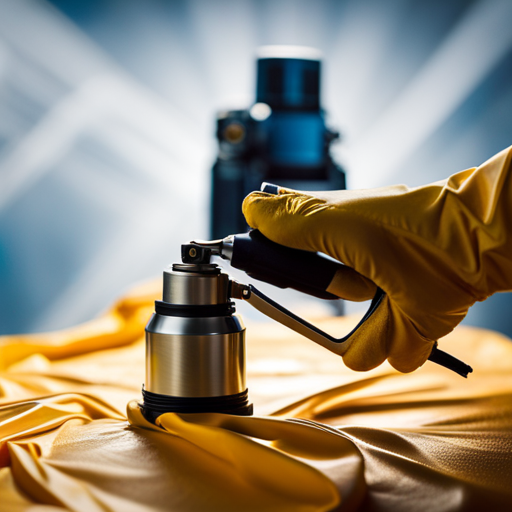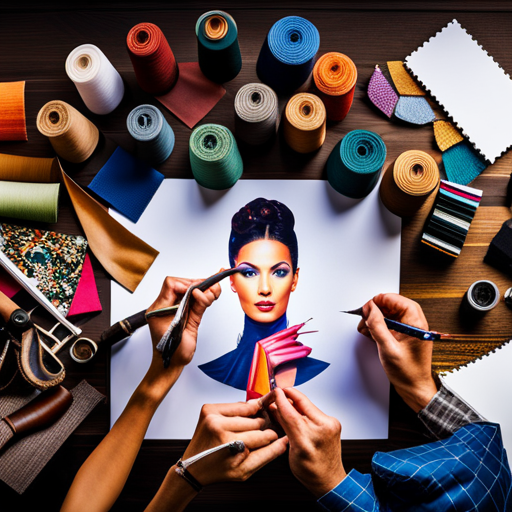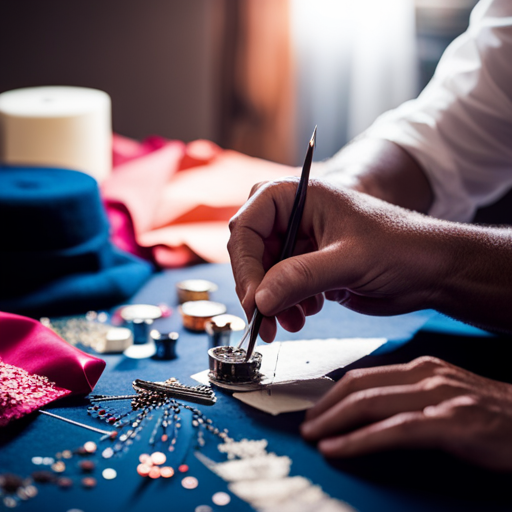Advanced Embellishment Techniques for Costumes

Step into the world of advanced costume embellishment techniques, where creativity knows no bounds and attention to detail reigns supreme.
From intricate beadwork to luxurious embroidery, elaborate appliqué designs to advanced fabric manipulation, this article explores the artistry and skill behind creating truly extraordinary costumes.
Discover the secrets of ornate trim and edging, complex layering and texturing, detailed sequin and rhinestone application, and innovative mixed media embellishments.
Elevate your costume creations to new heights with these advanced techniques.
Intricate Beadwork Techniques
The intricate beadwork techniques’ delicate artistry enhances the visual appeal and opulence of costumes. Bead weaving techniques and advanced bead embroidery contribute to the exquisite detailing that sets costumes apart.
The process of bead embellishment placement requires skill and precision to ensure that the design complements the garment’s overall aesthetic. This involves careful consideration of color blending, creating a harmonious balance that enhances the visual impact of the beadwork. Beadwork color blending is an art form in itself, requiring an understanding of color theory and the ability to create depth and dimension through the strategic placement of beads.
Mastering these techniques allows costume designers to elevate their creations, adding a layer of sophistication and luxury. The interplay of light and texture created by advanced bead embroidery and bead weaving techniques adds depth and dimension to the costume, captivating the audience and leaving a lasting impression.
As we delve into the realm of luxurious embroidery methods, it becomes evident that beadwork lays a foundation for the intricate detailing that defines opulent costumes.
Luxurious Embroidery Methods
With the foundation of intricate beadwork techniques firmly established, the exploration of luxurious embroidery methods further elevates the opulence and sophistication of costume embellishments. When it comes to creating lavish and intricate costume designs, incorporating couture stitching techniques and advanced lacework methods can truly elevate the overall aesthetic.
Luxurious embroidery methods offer endless possibilities for opulent embellishment styles, from delicate floral motifs to intricate geometric patterns. Additionally, experimenting with luxe fabric embellishment ideas such as incorporating metallic threads, pearls, and Swarovski crystals can add a touch of glamour and extravagance to any costume. Furthermore, the art of embroidery allows for the use of three-dimensional embellishments, creating a sense of depth and texture that truly sets the costume apart. When executed with precision and attention to detail, these techniques can transform a simple garment into a breathtaking work of art, exuding luxury and elegance.
As we delve into the realm of elaborate costume embellishments, let’s now transition into exploring the intricate world of elaborate appliqué designs.
Elaborate Appliqué Designs
Exploring the realm of elaborate costume embellishments, the integration of elaborate appliqué designs introduces a dynamic dimension to the opulent aesthetic previously established through luxurious embroidery methods.
Appliqué design inspiration can be drawn from a myriad of sources, including nature, historical motifs, and contemporary art, offering endless possibilities for creating stunning and unique designs.
Fabric embellishment trends play a significant role in shaping appliqué designs, with the current focus on incorporating three-dimensional elements such as metallic threads, sequins, and beads to add depth and texture to the appliqués.
Additionally, the use of laser-cut fabrics and innovative heat-press techniques has revolutionized the way appliqués are created, allowing for intricate and elaborate designs to be produced with precision and efficiency.
This evolution in technology has opened up new avenues for creativity, enabling costume designers to push the boundaries of traditional appliqué methods and explore avant-garde design concepts.
Advanced Fabric Manipulation
Fabric manipulation is the art of transforming a flat piece of fabric into a three-dimensional form through techniques like pleating and ruching, as well as fabric draping. These advanced techniques require a keen understanding of fabric properties and an eye for creative design.
Pleating and Ruching
The technique of pleating and ruching involves advanced fabric manipulation to create intricate and dimensional textures in costume design. This technique offers a wide range of creative possibilities, allowing costume designers to add depth and visual interest to their creations.
Some variations of pleating include accordion pleats, box pleats, sunburst pleats, and crystal pleats, each offering unique textures and visual effects.
Ruching effects, on the other hand, can range from delicate and subtle gathers to more dramatic and sculptural ruching, adding dynamic and fluid elements to the costume design.
Fabric Draping Techniques
Utilizing advanced fabric manipulation, costume designers employ intricate fabric draping techniques to create dynamic and visually captivating costumes. Creative draping involves the artful manipulation of fabric to achieve unique and aesthetically pleasing shapes, folds, and textures. Fabric sculpting, a key aspect of this technique, allows designers to mold and shape fabric into three-dimensional forms, adding depth and dimension to the costume.
By skillfully draping fabrics such as silk, chiffon, or organza, designers can create fluid and graceful lines that enhance the movement and silhouette of the costume. These advanced fabric manipulation techniques enable designers to push the boundaries of traditional costume design, resulting in stunning and innovative creations that embody both artistry and functionality.
Transitioning into the subsequent section, ornate trim and edging options provide the finishing touches to these meticulously crafted costumes.
Ornate Trim and Edging Options
One can enhance the visual appeal of costumes through the strategic use of ornate trim and edging options. These options not only add intricate details but also elevate the overall aesthetic of the attire. Consider the following creative embellishment options:
-
Creative fringe options: Experiment with various types of fringe, such as beaded, sequined, or feathered, to add movement and texture to the costume.
-
Vintage lace embellishments: Incorporate delicate vintage lace to infuse a touch of timeless elegance and sophistication into the costume design.
-
Metallic thread detailing: Utilize metallic threads to accentuate specific design elements, creating a striking visual impact and adding a touch of opulence.
-
Tassel and fringe combinations: Combine tassels and fringe to create dynamic, multidimensional trimmings that bring a sense of luxury and drama to the costume.
These ornate trim and edging options offer endless possibilities for creating visually stunning costumes with intricate detailing and exquisite craftsmanship. The strategic use of these embellishments can elevate the overall look, making the costume truly stand out.
As we delve into the complex layering and texturing in the subsequent section, these ornate trim and edging options will serve as the foundation for creating captivating and elaborate costume designs.
Complex Layering and Texturing
Incorporating a variety of textures and layering techniques into costume design can significantly enhance its visual appeal and elevate the overall intricacy of the attire.
Texture layering involves the strategic placement of different fabrics and materials to create depth and interest. By combining sheer, matte, and glossy textures, a multidimensional effect is achieved, adding depth and richness to the costume.
Dimensional embellishments, such as ruffles, pleats, and appliques, further contribute to the complexity of the design. These elements not only catch the light in various ways but also create movement, giving the costume a dynamic and captivating presence on stage.
Additionally, layering techniques can involve the use of overlays, insets, and contrasting panels to add visual interest and complexity to the costume’s silhouette. When executed thoughtfully, these techniques can transform a simple design into a visually stunning and elaborate creation, capturing the attention of the audience and enhancing the overall performance.
Transitioning into the subsequent section about ‘detailed sequin and rhinestone application’, it is important to understand how these intricate details can further elevate the costume’s visual impact.
Detailed Sequin and Rhinestone Application
When it comes to elevating the visual impact of costumes, detailed sequin and rhinestone application can make all the difference.
The art of strategically placing sequins and enhancing with rhinestones requires precision and a keen eye for design.
In this segment, we will explore expert tips for sequin placement and techniques for incorporating rhinestones to achieve stunning embellishments.
Sequin Placement Tips
Sequin and rhinestone application requires precision and attention to detail to achieve a professional and polished look on costumes. To ensure a stunning result, consider the following tips:
-
Sequin color coordination: Experiment with different color combinations to create visually striking designs.
-
Creative sequin patterns: Think outside the box and explore unique patterns to add depth and dimension to the costume.
-
Sequin density control: Strategically adjust the spacing between sequins to control the overall visual impact.
-
Sequin size variation: Incorporate a mix of sequin sizes to add texture and visual interest to the costume.
Enhancing With Rhinestones
Employing precise techniques for rhinestone application enhances the intricate detailing begun with sequin placement, elevating the overall visual impact of costume embellishments. When it comes to rhinestone placement, it’s essential to consider the design’s flow and the costume’s movement to ensure that the rhinestones catch the light from all angles.
Experimenting with different color combinations of rhinestones can create stunning visual effects, adding depth and dimension to the costume. Using contrasting or complementary colors strategically can highlight specific areas of the costume, drawing attention to the performer’s movements on stage.
Furthermore, the size and shape of the rhinestones play a crucial role in creating a captivating look.
Transitioning from intricate rhinestone applications, let’s delve into the art of innovative mixed media embellishments.
Innovative Mixed Media Embellishments
The use of innovative mixed media embellishments in costume design allows for a unique fusion of materials, textures, and visual interest. This approach opens up a world of creative possibilities, offering costume designers the chance to experiment with unconventional materials and techniques.
Some of the most exciting and effective mixed media embellishments include:
-
Metallic Foil: Adding metallic foil accents to costumes can create a stunning and eye-catching effect. Whether used to highlight specific details or as an all-over embellishment, metallic foil brings a touch of glamour and sophistication to the design.
-
Paper Mache: Employing paper mache in costume embellishments allows for lightweight yet durable additions. It is a versatile medium that can be molded and shaped to create intricate textures and forms, adding depth and character to the costume.
-
Textile Collage: Combining a variety of fabrics and textiles through collage techniques adds rich layers and dimensions to costumes. Textile collage allows for intricate patterns, color blending, and tactile appeal, resulting in visually captivating designs.
-
Resin Casting: Incorporating resin casting in costume embellishments provides a way to add intricate details and unique ornaments. From jewels and gemstones to custom-shaped elements, resin casting enables designers to create bespoke embellishments that enhance the overall aesthetic of the costume.
Frequently Asked Questions
How Can I Incorporate LED Lights Into My Costume Embellishments for a Unique and Eye-Catching Effect?
To create a unique and eye-catching effect, consider incorporating programmable LED patterns into your costume embellishments. Customized sound-activated lighting can enhance the visual appeal, providing an innovative and attention-grabbing element to your costume design.
Are There Any Advanced Techniques for Creating 3D Elements, Such as Sculptural Fabric Flowers or Dimensional Beading?
Advanced techniques for creating 3D elements like sculptural fabric flowers or dimensional beading require precision and artistry. Sculptural fabric techniques involve intricate folding and shaping, while dimensional beading innovations use various stitches and materials for depth and texture.
What Are Some Techniques for Incorporating Unconventional Materials, Such as Metal or Acrylic, Into Costume Embellishments?
Incorporating unconventional materials like metal and acrylic into costume embellishments requires innovative techniques. Ensuring durability is crucial, necessitating mixed media approaches. Metal embellishments can be incorporated through techniques like metal embossing, while acrylic pieces can be shaped and molded.
Can You Provide Tips for Creating Intricate Lace or Crochet Embellishments to Add a Delicate and Elegant Touch to Costumes?
Creating intricate lace patterns and crochet techniques require attention to detail and precision. To add a delicate and elegant touch to costumes, consider using fine yarns, intricate stitches, and incorporating unique design elements for a stunning finished look.
How Can I Use Advanced Fabric Manipulation to Create Dynamic and Fluid Movement in My Costume Design?
Fabric draping and movement enhancement techniques are essential in creating dynamic and fluid costume designs. Innovating embellishments and manipulating fabric to achieve fluidity is crucial for adding depth and visual interest to the overall design.
Conclusion
In conclusion, the advanced embellishment techniques for costumes offer a plethora of intricate beadwork, luxurious embroidery, elaborate appliqué, advanced fabric manipulation, ornate trim and edging, complex layering and texturing, detailed sequin and rhinestone application, and innovative mixed media embellishments.
These techniques provide costume designers with a wide range of options to create stunning and unique costumes for various performances and events.

Rufus Whitver is a passionate costume artisan and the creative mind behind layuo.com. With a keen eye for detail and a flair for imaginative design, Rufus brings characters to life through the art of costume making. His expertise encompasses a wide range of styles, from historical recreations to fantastical creations. Through layuo.com, Rufus shares insights, tutorials, and a portfolio showcasing his exceptional craftsmanship, inspiring fellow enthusiasts to embark on their own journey into the world of stunning costumes.





